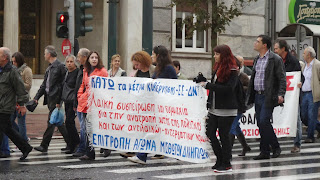 |
| Acropolis at Night with cranes and all |
Our introduction to Athens started with the drive from the airport which passed the Panathenaic stadium where in 1896 the modern Olympics were launched and was followed with a view of the Parthenon (complete with cranes - best viewed in the dark) from the balcony of our room. In a nutshell our Athens experience included a private tour of the Acropolis & the impressive new Acropolis Museum, an overview of Greek Food by a local expert, visiting a few museums and churches, wandering streets & alleyways tripping over ancient ruins, the usual shopping "sprees" and making the most of our last opportunity to enjoy the fine local food.
Our first activity was finding our way to the Monastiraki district, renowned for it's numerous restaurants offering souvlaki (Warm pita, grilled marinated meat, yoghurt, lettuce and tomato … served with french fries)….Just the thought makes us hungry again.
 |
| Souvlaki with fries |
Our guided Acroplis Tour began with a visit to the new Acropolis Museum. While the museum is built over ruins from the old city, every effort was made to preserve the ruins and make them viewable through a glass floor (covered with a grid of black dots to help viewers maintain their perspective). The Acropolis Museum is home to the remaining few original major artifacts from the area. Many of the original pieces from the Parthenon are in London, moved there by Elgin. One unusual display is the Marathon Cup awarded to the marathon winner in the first modern Olympics in 1896. It is lovely.
A column from the "Porch of the Caryatids", a recreation of the set of the greater than life-size sculptures from the Parthenon (featuring copies of the "Elgin Marbles") and the 6-8" high Marathon Cup.
The Acropolis includes the ruins of the Parthenon and several other structures. It has been built, rebuilt, extended, and shot at over the centuries and like many similar sites around the world is constantly under restoration. There are also some good views of the surrounding area.
Theater of Dionysos and view of city view looking NE toward Lykavittos Hill
The changing of the guard at Tomb of the Unknown Soldier was quite interesting. It was odd. We arrived late. But a few minutes before the action started, the police started moving the folks in front back away from things in order to leave maybe 10 meters from some pretty nebulous point. As a result we were left with a pretty much front line positioning. Seeing the event is worth it just for the march step and costumes of the guards. Love the kilts & the pom-pom clogs.
Our Food Tour began in the central market and wandered around several nearby streets where we sampled Greek pastries, meats, cheeses, and olives.
 |
| Flying pastry dough |
 |
| Hung-up on cured meats |
 |
| A small selection of olives |
We also had the opportunity to see one of the local pastries being prepared, quite an impressive process. The end result, galaktoboureko (custard filled phyllo dough), was quite tasty, as were the "doughnuts".
 |
| Greek Donuts / Loukoumades |
 |
| Galaktoboureko |
The most amazing thing happened on this tour. The guide told us he prefers working with Americans. They are more open, friendly, curious, … than Europeans. Hey, what ever happened to "The Ugly American"?
The National Archeological Museum covers the history and culture of Greece. With so much to cover plan on a 2-3 hour overview or several days for an in-depth experience. A few samples of the displays from our 2 hours visit.
 |
| Zeus or Poseidon? |


A visit to the Benake museum is worth a hour or more depending on your interest in the antiquities, history, and costumes around Greece. We enjoyed looking at the variations in dress throughout the country.
Dining is easy, just walk along the street and you will be encouraged to view a large number of menus, featuring mostly Greek dishes with slight variations and a reasonable wine lists including some fine Greek vintages. Typical Athenians eat lunch after 3PM and dinner at 9+ (restaurants are mostly empty earlier, note that we were there in off-season).
Shops were open long hours but few buyers were visible. On Sunday the stores were open for the first time ever and there were crowds. Maybe a good sign for their economy.
And, not to missed, a protest on our last day. A quite civilized event. We were somewhat surprised when they very politely slowed up to let us cross the street.














































